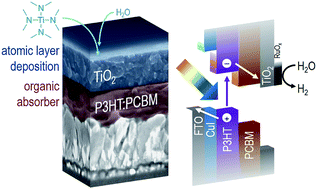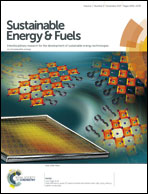Stabilizing organic photocathodes by low-temperature atomic layer deposition of TiO2†
Abstract
Organic semiconductor light absorbers are receiving attention for their potential application in photoelectrochemical (PEC) cells for renewable fuels generation. Key to their advancement is precise control of the interfaces between charge-selective contacts, absorber layers, and electrocatalysts, while maintaining compatibility with an aqueous electrolyte environment. Here we demonstrate a new process for low-temperature atomic layer deposition (ALD) of TiO2 onto a P3HT:PCBM polymer blend surface for stable high-performance organic PEC photocathodes. This ALD TiO2 layer provides three key functions: (1) formation of an electron-selective contact to the polymer to enable photovoltage and photocurrent generation, (2) a robust interface for conducting charge between the photoabsorber and electrocatalyst layers, and (3) a pinhole-free barrier to water penetration, preventing corrosion of the underlying materials. The resulting device based on the architecture CuI/P3HT:PCBM/TiO2/RuOx showed excellent performance and stability during PEC hydrogen-evolution. More broadly, the achievement of ALD film formation on a polymer surface opens doors in the field of functional organic–inorganic electronic interfaces.

- This article is part of the themed collection: 2017 Sustainable Energy and Fuels HOT Articles


 Please wait while we load your content...
Please wait while we load your content...